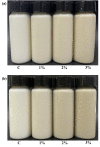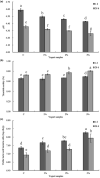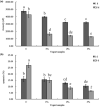Physicochemical, sensory, and antioxidant characteristics of stirred-type yogurt enriched with Lentinula edodes stipe powder
- PMID: 37823167
- PMCID: PMC10563725
- DOI: 10.1002/fsn3.3563
Physicochemical, sensory, and antioxidant characteristics of stirred-type yogurt enriched with Lentinula edodes stipe powder
Abstract
The Lentinula edodes stipe (LES), a by-product of L. edodes fruiting body processing, is rich in dietary fiber, protein, and polysaccharides, which can be served as the functional ingredient in dairy products. In this study, stirred yogurts fortified with 1%, 2%, and 3% LES were prepared, and the effects of LES on the changes in color, pH, titratable acidity (TA), viable lactic acid bacteria (LAB) cells, syneresis, viscosity, texture, and antioxidant activity of the flavored yogurt were monitored at the beginning and the end of storage. The LES decreased the lightness, increased the red-green color values and yellow-blue color values, decreased the pH values, and increased the contents of TA, the viable LAB cells, and the antioxidant activity of yogurt samples in a dose-dependent manner. The addition of LES showed double-edged effects on the texture of yogurt, which significantly reduced firmness and viscosity but decreased the syneresis. Compared with plain yogurt, the 2% LES-fortified yogurt exhibited similar index values of texture parameters and higher scores of the appearance, fermented odor, taste quality, and overall acceptance, suggesting that this might be the optimal dose for industrial production. After cold storage for 28 days, pH values of all yogurt samples further decreased with increasing of TA. Interestingly, syneresis of LES-fortified yogurt decreased and the viable LAB cells and antioxidant activity of 3% LES-fortified yogurt slightly decreased. Therefore, LES is beneficial to improve physicochemical, sensory, and antioxidant properties of yogurt, which has the potential to be used in functional dairy products.
Keywords: LES; antioxidant activity; physicochemical property; sensory evaluation; stirred yogurt.
© 2023 The Authors. Food Science & Nutrition published by Wiley Periodicals LLC.
Conflict of interest statement
The authors declare that they have no conflict of interest.
Figures




References
-
- Celik, S. , & Bakirci, I. (2003). Some properties of yoghurt produced by adding mulberry pekmez (concentrated juice). International Journal of Dairy Technology, 56(1), 26–29.
-
- Chen, W. , Li, W. , Yang, Y. , Yu, H. , Zhou, S. , Feng, J. , Li, X. , & Liu, Y. (2015). Analysis and evaluation of tasty components in the pileus and stipe of Lentinula edodes at different growth stages. Journal of Agricultural and Food Chemistry, 63(3), 795–801. - PubMed
-
- Chou, W. , Sheih, I. , & Fang, T. (2013). The applications of polysaccharides from various mushroom wastes as prebiotics in different systems. Journal of Food Science, 78(7), M1041–M1048. - PubMed
LinkOut - more resources
Full Text Sources
Miscellaneous

